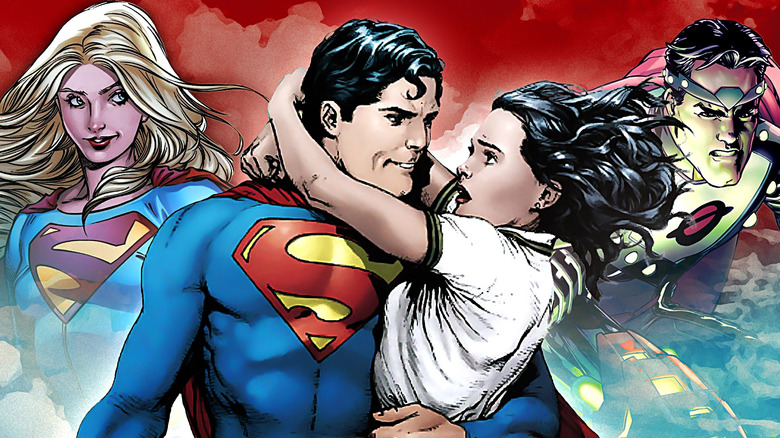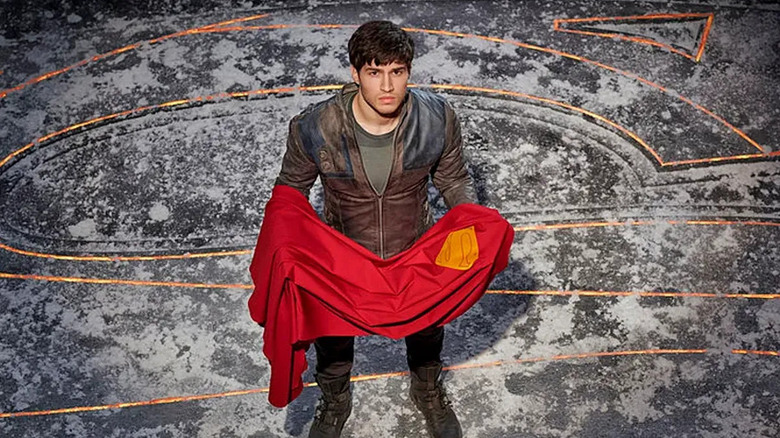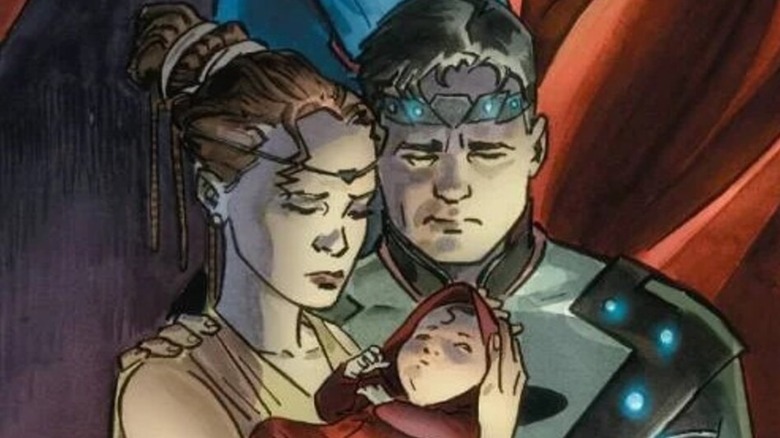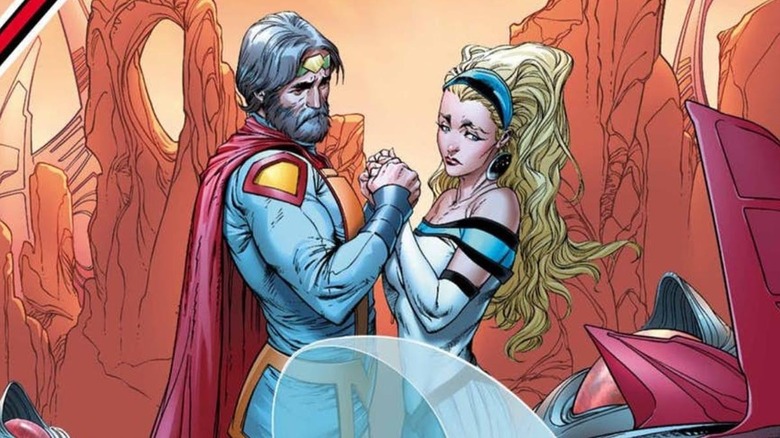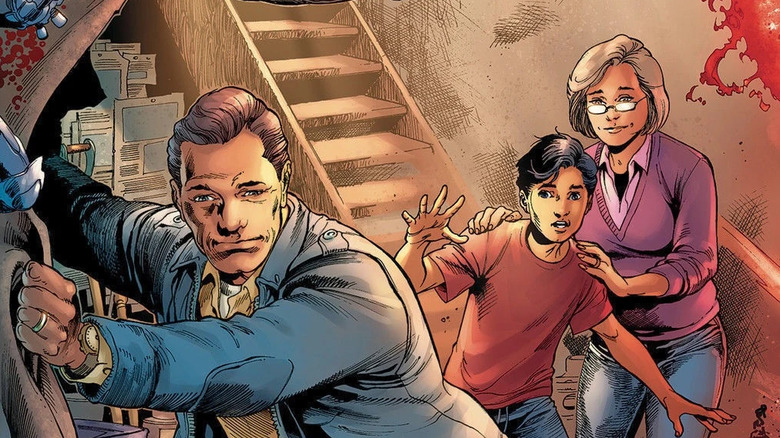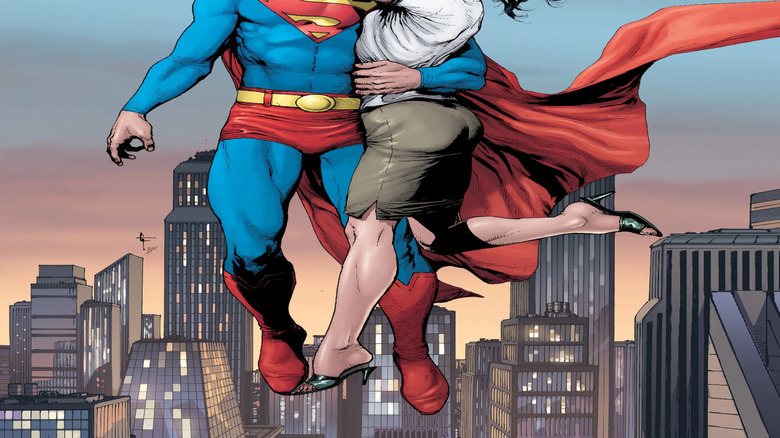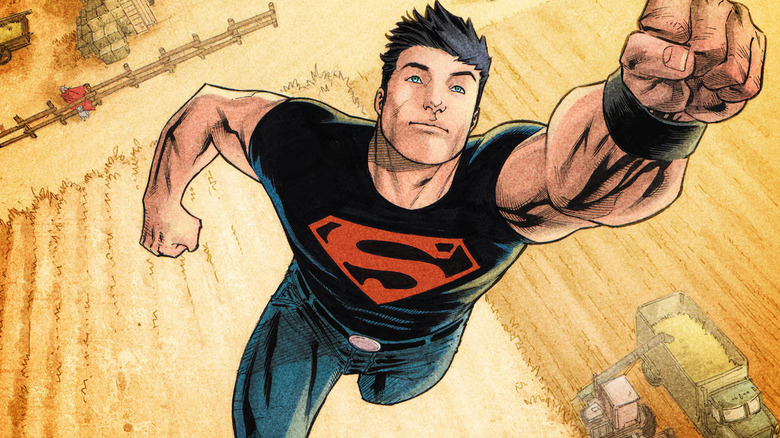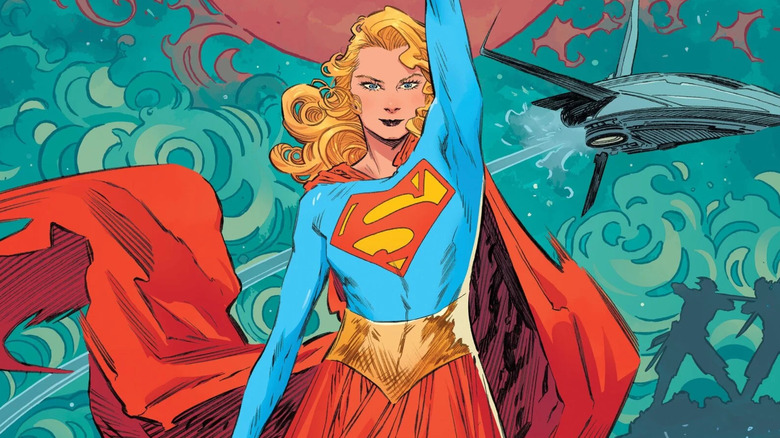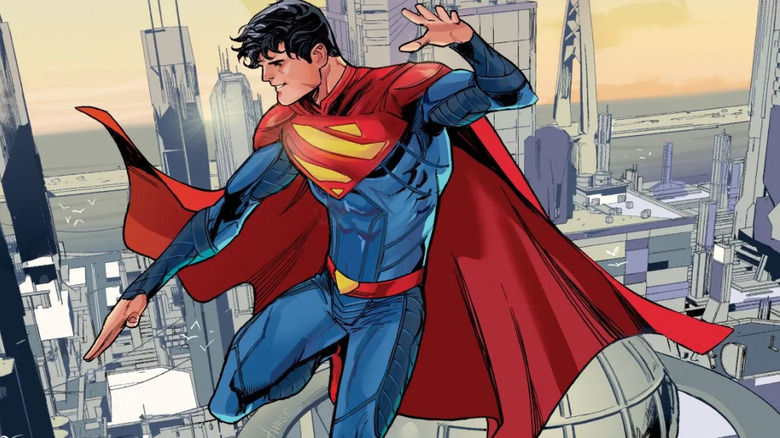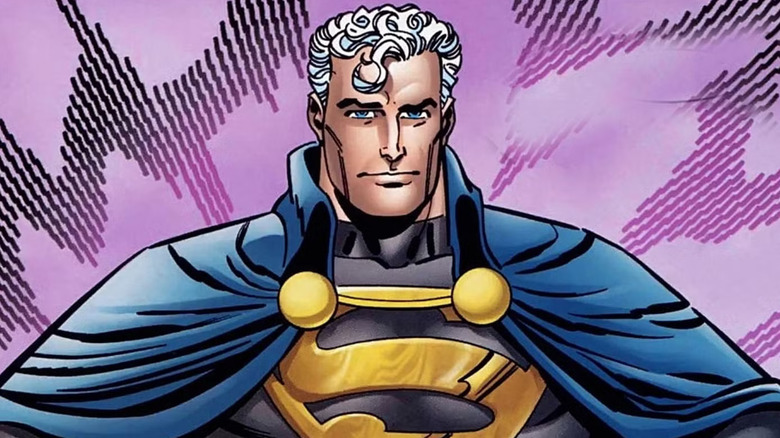Superman: Clark Kent/Kal-El's Family Tree, Explained
When comic book fans think of their favorite fictional families, a few will immediately spring to mind. The sprawling, adoptive family of Bruce Wayne will surely come up first for many, with so many distinct and individually successful members among their ranks who have gone on to become solo stars in their own right, like Nightwing and Red Hood. They might also think of the close brotherhood of the Teenage Mutant Ninja Turtles, the found mutant family of the X-Men, or even the multiversal brood of Spider-Man. Regardless of who they favor, it's likely few of them immediately think of the House of El.
In spite of how popular Superman is, his family tree has historically received relatively little attention from comics. He has no siblings, his children are often hypothetical and relegated to easily erasable alternate timelines, and his parents — whose deaths on Krypton are meant to define parts of his identity — are not even reliably dead, depending on the continuity. This lack of stability and consistency regarding his lineage has made it hard to process as a whole, even as DC admirably tries to establish a single, lasting child in his life.
With James Gunn's upcoming "Superman" film set to establish a definitive contemporary cinematic take on the character's mythos (while speeding toward the introduction of his equally compelling cousin), there's no better time to study all the potential roots and branches of the Superman family tree. Though it will require considering numerous retcons, reboots, and conflicting popular versions of these characters, understanding the history and possible future of the House of El is quietly crucial to understanding why Superman became the Man of Tomorrow.
Superman's Kryptonian relatives
The House of El existed many generations before the rebellion of Jor-El and the birth of his super son. The earliest known member of Krypton's most impactful family is Kem-L, a distant ancestor of Kal-El who was a member of the power-drunk Kryptonian Science League for an unknown number of years (over 200,000 at least) before Jor-El's birth. His most notable contribution to the DC Universe at large is the invention of the Eradicator, a weapon commissioned by the Science League to assassinate a visiting religious missionary known as the Cleric, who warned against some of the advanced scientific practices pioneered by Krypton. Kem-L imbued the Eradicator with great power, as well as his own isolationist point of view — thus, the weapon became a warden for the planet, preventing anyone from entering or exiting. Cleric ultimately rid Krypton of the Eradicator, but the weapon survived long enough to manifest a physical body, and even tried to impersonate Superman after he was killed battling Doomsday in the "Death of Superman" storyline.
Moving many generations ahead, DC has provided some sparse details about figures of the House of El directly leading up to Jor-El, some of whom were showcased and explored in more depth on the short-lived SyFy series "Krypton." Val-El, a minor Kryptonian character in "Superman" comics, was named as Kal-El's great-great grandfather. After attempting to warn the Science Council about the impending danger of Brainiac, he was sentenced to death. Though this is not canonical to the comics, Val-El's son, Ter-El, is also from the comics and is canonically Kal-El's great grandfather. Finally, we have Seyg-El, Ter-El's son and Kal-El's grandfather. In the comics, we know very little about Seyg-El beyond the fact that he seems to align more closely with Kryptonian values than his son Jor-El.
Jor-El and Lara Lor-Van -- Superman's biological parents
To even casual DC Comics fans, Jor-El is one of Kal-El's more recognizable Kryptonian relatives. The character has been brought to life on screen numerous times, most notably in the original 1978 "Superman" film (in which he is played by a very reluctant Marlon Brando) and Zack Snyder's "Man of Steel" (played by Russell Crowe). Jor-El is Kal-El's father and the leader of the House of El at the time of Krypton's destruction.
His origins have been remixed and reinvented as many times as DC has rebooted their "Superman" line of comics, but the common narrative threads between most iterations of the character is that he was a rebellious but brilliant Kryptonian scientist who foresaw the planet's destruction before anyone else. Though he tried to warn the Kryptonian Science Council about the danger, they refused to listen, and he was thus compelled to send his infant son to Earth to ensure the survival of his family. Lara Lor-Van — Jor-El's wife and Kal-El's mother — stands with her husband during this ordeal. In some iterations of her story (which depict her as a member of the Kryptonian military) she even turns on her planet to defend Jor-El with her life. It is consistent in most iterations that she and Jor-El shared a rare, genuine connection that was looked down upon by the unfeeling Kryptonians.
Jor-El alone is usually able to remain in Kal-El's life after the destruction of Krypton, albeit in an artificial capacity. In some stories, he merely leaves his son with recordings, which Kal-El uses to learn about his homeworld and heritage — in others, he is effectively able to put a transferable version of his personality and memory into the vessel with Kal, basically making him a limited A.I. In the New 52, Jor-El was revealed to have survived Krypton's destruction, and actually became a major antagonist in one of the era's final storylines.
Zor-El and Alura In-Ze -- Superman's aunt and uncle
Before we leave the old world of Krypton and the House of El behind for a moment to talk about Kal-El's Earthly relatives, we need to talk about two more important Kryptonians — Kal's Aunt Alura In-Ze and Uncle Zor-El.
Zor-El was the younger brother of Jor-El, the two both usually working as controversial scientists in Kryptonian society. In most stories, Zor-El provides something of a foil to Jor-El in terms of his relationship to their vision of Krypton's bleak future — in some, Zor-El does not believe Jor-El's prediction, leading to a rift between brothers that is never healed; in others, he always believes Jor-El's prediction, but his single-minded devotion to cutting-edge science throws his perspective and sanity into question. Prior to Krypton's destruction, Zor-El married another Kryptonian scientist named Alura In-Ze, and the couple had a single child they named Kara. When it became clear their planet would not survive the impending environmental catastrophe, they too made the difficult decision to send their child on a rocket toward the stars, never to see her again.
Or, so they thought. Unlike Jor-El and Lara Lor-Van, Zor-El and Alura In-Ze survive Krypton's destruction in most continuities, finding refuge in the miniaturized bottle-city of Kandor. In the predominant Post-Crisis storyline, the citizens of Kandor are charged with rebuilding a New Krypton on another planet. The majority of them — including Zor-El — are tragically killed by the nuclear supervillain Reactron, acting on the orders of the U.S. military. Subsequent continuities have experimented with their impact on the DC Universe to interesting but largely inconsequential effect (continuity-wise, at least). In the New 52, Zor-El is transformed into the deranged supervillain known as Cyborg Superman, and survives to fight his own daughter in the present day; in the "Arrow" and "Supergirl" multiverse, Alura In-Ze is a major antagonist whose cold, scientific moral calculus conflicts with her daughter's desire to inspire hope.
Jonathan and Martha Kent -- Superman's adoptive parents
When Kal-El's rocket was launched from the dying Krypton toward Earth, there was no telling where exactly it would land. This seemingly minor aspect of chance has actually factored into a great deal of Elseworld DC storytelling. Had the rocket landed in the densely populated city of Metropolis claiming hundreds of lives, it's possible the child would've been captured and subsequently experimented upon by the U.S. government (as he was in "Flashpoint"); had he landed in Soviet Ukraine during the Cold War, he could've become a weapon of the USSR ("Superman: Red Son"); there's even a story where landing in Gotham City leads him to becoming Batman.
In the mainstream DC Comics continuity, however, Kal-El fortunately lands near the farm of Jonathan and Martha Kent, located in the small, rural town of Smallville, Kansas. Upon discovering the helpless baby struggling in the ship, they choose to raise him as their own son and give him the name Clark. (In some continuities, the Kents were unable to have a child biologically, and thus treat Clark like a miracle sent from the heavens.) When Clark matures and begins to develop super powers, Ma and Pa reveal to him how he came to be in their lives. At this point, in most stories, Clark first encounters the recordings left behind by Jor-El.
In many versions of the Superman origin story, Jonathan is notable for dying while Clark is a young man or teenager, an event that often teaches the Man of Steel that he won't always be able to save everyone. In "Smallville," Jonathan died of a simple heart attack — in "Man of Steel," he was killed by a tornado (funnily enough, this wasn't the script element that disappointed Kevin Costner the most). As for Martha, she typically survives as a beacon of stability in Clark's life — and, in one instance, the focus of one of Superman's most infamous film scenes.
Kal-El/Clark Kent -- Superman
Obviously, almost everyone knows what happens after young Clark Kent learns he's actually also Kal-El, the alien heir to the House of El. Under the guidance of his Earthly parents Jonathan "Pa" and Martha "Ma" Kent, with the lessons left to him by his Kryptonian father Jor-El, Clark/Kal fights to make sense of his complicated heritage. In the process, he develops a sense of profound, universal empathy that drives him to be the one and only Superman. But he's far from where this family tree ends — to continue further, we'll have to dig a little bit into the complicated love life of the Man of Steel.
Clark has had many serious relationships throughout his comics history, any one of which could have realistically led to children and marriage. Growing up in Smallville, he was in love with a classmate named Lana Lang. As they became older, she was the most notable woman in his life — aside from, of course, Daily Planet star reporter Lois Lane. Clark, Lana, and Lois developed something of a love triangle that persisted for years and re-emerged in several iterations of the "Superman" origin story. To Clark, Lana represented the simple life he had growing up, which taught him such compassion for others and instilled in him the deeply human values that allowed him to stay grounded despite his powers; Lois, on the other hand, represented his complicated but wonderfully layered life in Metropolis, where he learned that "good" people are capable of making mistakes as much as "bad" people are of making up for theirs.
Lois almost always proves to be the perfect match for Clark (their relationship serving as the basis for one of the best DC Comics TV shows ever), and the two usually end up married with children, as is the case in the current DC continuity. Otherwise, Clark has also settled down with fellow Justice Leaguer Wonder Woman.
Superman's genetic clones
Though Kal-El's most prominent relatives currently are his "super" cousin and son, there's no denying that his closest relatives are his "siblings" — or, rather, the various clones that were made from his genetic framework without his knowledge or consent. Because, comics.
Fans of the massively popular Cartoon Network animated DC series "Young Justice" will likely immediately think of Kon-El, a clone of Kal-El that also incorporated the DNA of his archnemesis Lex Luthor. He is freed from his scientific captivity before reaching full maturity and chooses thereafter to fight crime as the young superhero Superboy. In the comics, Superboy is a reckless and immature kid — in both "Young Justice" and the live-action series "Titans," this immaturity presents itself in a more isolated, stoic manner, with Kon-El/Connor Kent keeping few friends. Kon himself was later cloned by the Suicide Squad-adjacent shadow organization known as "The Agenda." This being — who possessed greater physical capabilities than Superboy but lacked his humanity and intelligence — was dubbed "Match," and briefly led Task Force X before he was ultimately defeated. Kon's story bears some resemblance to that of Cir-El, another clone of Superman who was created by Brainiac in the distant future. She becomes the Supergirl of this timeline, and considers Kal-El to be her father.
In some continuities, the powerful "Superman" villain Bizarro is introduced as an imperfect clone of the Man of Steel developed by Luthor (historically, Bizarro hails from an alternate universe called Bizarroworld, where imperfect opposites of everyone in the DC Universe exist). Despite being a retcon, the Luthor-cloning plot point has proved so persistently intriguing that it's rumored to factor into James Gunn's "Superman" origin story.
Kara Zor-El -- Superman's cousin
After Superman's aunt and uncle Alura In-Ze and Zor-El send their daughter Kara into space, it takes her much longer than their nephew Kal-El to arrive on Earth. In some versions of the story, they had hoped that their teenage daughter would be able to protect her infant cousin — but by the time her spacecraft lands, Kal has fully matured into the all-mighty Superman, while the effects of intergalactic space travel have prevented Kara from growing past the age of about 16.
Kara Zor-El — aka Kara Danvers — has become an incredibly popular comic book character in her own right, thanks in large part to the TV show "Supergirl." The series characterizes her as a quirky hero in the making, whose desire to live up to her cousin's legacy as Superman drives her to champion his values of truth, justice, and the American way. This is only partially true to the comics. As James Gunn has teased for the upcoming DC Studios adaptation of Tom King's "Supergirl: Woman of Tomorrow" (which will feature "House of the Dragon" star Milly Alcock as DC's new Supergirl), the character's lived experience on Krypton and more difficult journey to Earth have made her a harsher, more messed-up hero than Superman. The raw and ruthless strength showcased by Sasha Calle's Supergirl in "The Flash" is actually one of the few things the 2023 film totally nails with regard to the source material.
Jon Kent -- Superman's son
Superman has had numerous hypothetical children in various continuities. To simplify things for our purposes, we're going to afford the majority of our focus in this article to Jonathan Kent, the son Clark had with Lois Lane and, who by all appearances, seems to be the first Super Son to become a fixture of Superman's legacy.
As is the case with most super-children, Jon is born with his father's powers, making him the heir to the Superman mantle (Supermantle?). Learning to control these powers is a traumatic and difficult journey for Jon, though one that ultimately leads to him finding a close friend in Damian Wayne, the current Robin who also happens to be the son of Bruce Wayne. As much as he learns from spending time with another kid burdened with a complicated family and superheroic legacy, however, Jon ultimately decides he needs to venture into the outer reaches of space with none other than his grandfather Jor-El in order to be the Superman he needs to be.
Unfortunately, their journey was interrupted by Ultraman, the villainous, alternate-universe Superman from Earth-3, who captured Jon and held him prisoner in his home universe for several years. When Jon finally escaped back to his original Earth, only a few weeks had passed for his family — it had been close to seven years for him (in other words, Jon got magically aged-up so DC could replace Clark, because, comics). This young-adult Jon Kent is now a Superman in his own right, discovering himself as he becomes the hero he's destined to be.
Superman's potential descendents
But what about all those other Super-Offsprings? For various reasons (mainly that they are either potential children he had in alternate futures or the result of relationships that are no longer canon) they have little to no impact on current "Superman" stories. That doesn't mean these hypothetical branches are any less fascinating to examine.
In addition to Kon-El and Cir-El, Superman has adopted Kryptonian or Kryptonian-adjacent refugees into his family in some continuities. When the Daxamite Lar Gand crash landed on Earth with the powers of Superman and no memory of who he was, Clark embraced him as part of the House of El and christened him with the name Mon-El (he was soon after sent to the Phantom Zone for life-saving purposes, and was later released in the 30th century where he joined the Legion of Superheroes). Kal-El also once adopted Lor-Zod, the son of his worst Kryptonian enemy General Zod. In this continuity, Lor-Zod was christened Christopher Kent, and he eventually (and somewhat confusingly) chose to take up the mantle of Nightwing.
Speaking of the 30th century, one of Clark Kent's many hypothetical descendants named Richard Kent Shakespeare resides there as another member of the Legion of Superheroes. There are also several hypothetical Kent offspring that result from the potential union of Superman and Wonder Woman — this group includes Jonathan Kent II (aka Hyperman from the "Kingdom Come" timeline), Zod-Ur (a clone of their evil counterparts from the DC Animated Universe), and Bruce Kent (the last son of a doomed Earth, named after Bruce Wayne). With the idea of legacy being so integral to the "Superman" story, even these unrealized future manifestations of Kal-El's own legacy illuminate hidden parts of himself that exist in the present.
